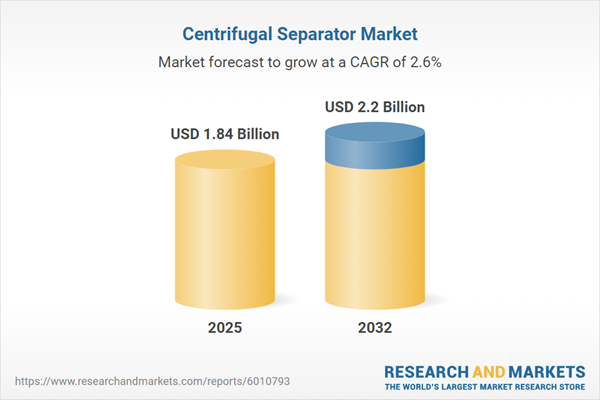Speak directly to the analyst to clarify any post sales queries you may have.
The centrifugal separator market continues to evolve rapidly, driven by technological innovation, stricter regulations, and the increasing need for efficient separation solutions across diverse industries. Senior decision-makers must stay ahead of these changes to remain competitive and resilient in a complex, constantly shifting landscape.
Market Snapshot: Centrifugal Separator Market Size and Growth
The centrifugal separator market grew from USD 1.79 billion in 2024 to USD 1.84 billion in 2025. It is expected to continue expanding at a CAGR of 2.59%, reaching USD 2.20 billion by 2032. Growth is driven by increasing demand for reliable solid-liquid and liquid-liquid separation equipment in industries such as chemical processing, oil and gas, pharmaceuticals, water treatment, and food and beverage.
Scope & Market Segmentation
This report delivers a comprehensive assessment of the centrifugal separator industry across the following:
- End User Segmentation: Chemical (basic, petrochemical, specialty), Food & Beverage (brewery, dairy, edible oil), Oil & Gas (downstream, midstream, upstream), Pharmaceutical (biotech, generic), Water Treatment (industrial, municipal)
- Type: Solid bowl separators, three phase, and two phase configurations
- Capacity: Small, medium, and large systems suitable for applications from laboratory to bulk industrial processing
- Material: Alloy steel, stainless steel, and plastics, each selected for particular corrosion resistance, hygiene, or application-specific requirements
- Design: Horizontal or vertical units to accommodate varied plant layouts and space restrictions
- Sales Channel: Direct sales and distributor networks to ensure optimal client support and product availability
- Regional Coverage: Americas, Europe, Middle East & Africa, Asia-Pacific – with analysis across markets including the United States, Germany, China, India, and Brazil, among others
- Leading Companies: Alfa Laval AB, GEA Group AG, Flottweg SE, Andritz AG, SPX Flow, Tetra Laval, Pieralisi S.p.A., Mitsubishi Kakoki Kaisha, Sharples Pump Company, and Krebs Maschinenfabrik AG
Key Takeaways: Strategic Insights for Senior Decision-Makers
- Digitalization is fundamentally reshaping centrifugal separator operations, enabling predictive maintenance and reducing downtime via real-time sensor monitoring and analytics.
- Industry 4.0 integration promotes smarter equipment with modular, customizable platforms, allowing quick adaptation to changing process requirements and enhanced lifecycle value.
- Environmental regulations are accelerating investment in energy-efficient separators, with emphasis on process optimization, waste minimization, and enhanced sustainability across verticals.
- Material advances, including high-performance alloys and composites, are unlocking new application areas and ensuring reliable operation under harsh operational conditions.
- Supply chain resilience is now paramount, with organizations diversifying sourcing and establishing regional partnerships to counteract volatility and logistics challenges.
- Strategic alliances between manufacturers and specialist consultancies are delivering turnkey separation solutions backed by robust support and value-added services.
Tariff Impact on Centrifugal Separator Supply Chains
Recently implemented United States tariff measures have produced significant shifts in supply chain strategies. Greater import duties on key separator materials have prompted manufacturers to reassess procurement priorities and seek local fabrication partnerships. As a result, the market is experiencing lengthier lead times, increased inventory buffers, and adjustments in supplier relationships, all aimed at enhancing resilience and reducing exposure to trade fluctuations.
Methodology & Data Sources
The centrifugal separator market analysis leverages structured interviews with professionals across top industrial sectors, underpinned by extensive secondary research including industry journals, patents, and regulatory filings. Data triangulation and expert validation workshops ensure that findings reflect current market realities and accurately capture evolving technology, compliance, and adoption trends.
Why This Report Matters
- Enables senior leaders to make informed capital expenditures and technology selection for optimal separation performance and operational continuity.
- Equips procurement, engineering, and strategy teams with actionable insights to manage risk, increase supply chain resilience, and strengthen regulatory compliance efforts.
- Guides organizations in aligning innovation strategies with market trends, regional opportunities, and customer demands for sustainable growth.
Conclusion
The centrifugal separator market is entering a period of steady, innovation-led expansion. Forward-thinking organizations that embrace digital tools, resilient procurement models, and sustainability-focused solutions will be positioned to harness future opportunities and lead industry transformation.
Additional Product Information:
- Purchase of this report includes 1 year online access with quarterly updates.
- This report can be updated on request. Please contact our Customer Experience team using the Ask a Question widget on our website.
Table of Contents
3. Executive Summary
4. Market Overview
7. Cumulative Impact of Artificial Intelligence 2025
Companies Mentioned
The companies profiled in this Centrifugal Separator market report include:- Alfa Laval AB
- GEA Group AG
- Flottweg SE
- Andritz AG
- SPX Flow, Inc.
- Tetra Laval International S.A.
- Pieralisi S.p.A.
- Mitsubishi Kakoki Kaisha, Ltd.
- Sharples Pump Company LLC
- Krebs Maschinenfabrik AG
Table Information
| Report Attribute | Details |
|---|---|
| No. of Pages | 186 |
| Published | November 2025 |
| Forecast Period | 2025 - 2032 |
| Estimated Market Value ( USD | $ 1.84 Billion |
| Forecasted Market Value ( USD | $ 2.2 Billion |
| Compound Annual Growth Rate | 2.5% |
| Regions Covered | Global |
| No. of Companies Mentioned | 11 |









